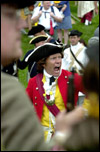|
Twenty-six-year-old Captain Robert Rogers had marched with 200 men for three days from Fort Edward north, along Lake George.
 During the trip, the French at Fort Ticonderoga (then known as Carillon) learned Rogers' men were in the area. An advance troop of approximately 95 men headed out from the fort to engage Rogers' Rangers, pushing forward approximately 15 minutes ahead of a larger 200-member force that followed from the fort. During the trip, the French at Fort Ticonderoga (then known as Carillon) learned Rogers' men were in the area. An advance troop of approximately 95 men headed out from the fort to engage Rogers' Rangers, pushing forward approximately 15 minutes ahead of a larger 200-member force that followed from the fort.
When Rogers' scouts spotted the first group, which was half the size of their force, Rogers' Rangers set up an ambush along Trout Creek, just west of the northern end of Lake George. With several feet of snow on the ground, the French and Indian forces traveled along the frozen surface of the brook, and as soon as they approached the rangers' location, many were shot where they stood. A vicious battle ensued, with rangers rushing forward to scalp the enemy and finish off the wounded.
Several rangers pursued their fleeing foes. But the French stopped, turned and started returning fire, having met the second, larger force from Fort Carillon. Rogers' Rangers were as surprised by the counterattack as the first group of French and Indian warriors had been when the rangers opened fire on them just a short time earlier.
 The larger force attacked Rogers' Rangers with brutal force, particularly the Indian warriors who saw their freshly slain and scalped comrades on the battlefield. The rangers were forced back and continued to fight throughout the day, even as the right flank troops were cut off from the rest of the rangers and captured. The larger force attacked Rogers' Rangers with brutal force, particularly the Indian warriors who saw their freshly slain and scalped comrades on the battlefield. The rangers were forced back and continued to fight throughout the day, even as the right flank troops were cut off from the rest of the rangers and captured.
Rogers and other survivors of the battle scrambled through the woods as darkness approached, heading back to the shores of Lake George in groups of just two or three. As many as 140 of Rogers' original squad of 200 men had been shot, stabbed, or scalped. The famed Rogers' Rangers had been beaten.
The French and Indian War would continue for another five years.
 In 1775, during the American Revolution, General George Washington was short on artillery to adequately face British troops in New England. Twenty-five-year-old Henry Knox, new to the colonial army, offered to bring heavy artillery from Fort Ticonderoga and other forts in the Adirondack region to Boston. In 1775, during the American Revolution, General George Washington was short on artillery to adequately face British troops in New England. Twenty-five-year-old Henry Knox, new to the colonial army, offered to bring heavy artillery from Fort Ticonderoga and other forts in the Adirondack region to Boston.
Knox and his men set out in November 1775 for what was considered by some an impossible mission. Working throughout the winter so the cannons would not sink on muddy roads, Knox compiled a virtual artillery parade of cannons and other heavy weapons. His troops pulled together mortars, howitzers and cannons - more than 50 pieces of artillery in all - and trudged through heavy snow and freezing temperatures for 300 miles with the load. The artillery weighed 119,000 pounds and  Knox used 82 sleds and teams of oxen over 40 days, heading from Fort Ticonderoga down through Lake George and on to Boston. Knox used 82 sleds and teams of oxen over 40 days, heading from Fort Ticonderoga down through Lake George and on to Boston.
There are countless stories to be told throughout the state - stories that bring history alive and make clear why New York is indeed, the birthplace of a nation.
Click on the tabs above to learn more about the Independence Trail.
Back to the Stories of the French & Indian and Revolutionary Wars. |


